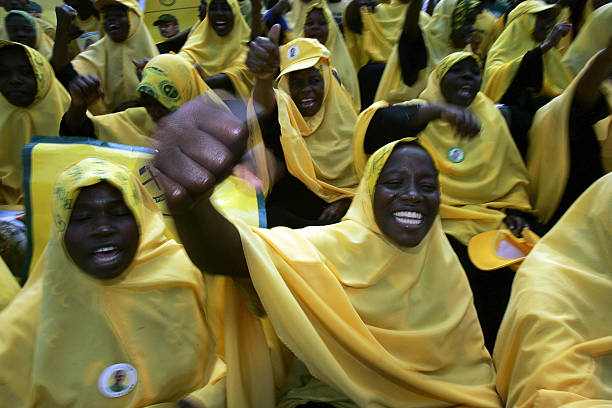Tanzania, in keeping with global political trends, reserves 30% of seats in parliament for women. These so-called special seats were introduced with multiparty politics in 1992, in response to the low numbers of women elected to positions of power.
There were only eight elected female parliamentarians after the first multiparty elections in 1995. Ten years later, 17 women were elected to parliament, representing 7% of legislative seats. Fast forward to the 2020 general elections: women make up 37.4% of parliament. However, only 27 women (10.2%) were elected directly from the 264 constituencies.
Special seats are credited for increasing women’s representation. This has enabled the passing of a couple of “gender sensitive” laws. However, the special seats system is not the magic bullet for achieving gender equality in political representation across the board.
While political parties have met the legal requirements for nominating women for special seats, concerns linger about the parties’ internal commitment to advancing women’s political participation.
In a recent paper I set out to assess whether the main political parties voluntarily sought to increase women’s participation in their internal leadership positions and candidate lists. In particular, I examined whether their constitutions contained voluntary gender quotas beyond fulfilling the quotas in the national statutes.
I found that the constitutions of both parties recognised women’s rights to representation as enshrined in international and regional conventions as well as national laws, but these commitments largely start and end with the establishment of a women’s wing. Men dominate the parties’ decision making organs at national and lower levels.
Since its establishment in 1992, Chama cha Demokrasia na Maendeleo (Chadema or Party of Democracy and Development) has never had a woman among its six main national leaders. The ruling Chama cha Mapinduzi (CCM, the Revolutionary Party) named its first female national chair and the first female deputy general secretary-mainland only in 2021. That is 44 years after the party was formed in 1977.
Where the parties stand
On the face of it, Tanzania has advanced women’s representation. President Samia Suluhu Hassan is one of the few female presidents the African continent has ever had. But that’s not by CCM’s constitutional design. The office of the president became vacant on 17 March 2021, when John Pombe Magufuli suddenly died in power. Suluhu, then the first female vice president in the history of Tanzania, became president.
She was elected CCM’s chair in keeping with the party’s tradition that the president is the party leader.
In addition, for about two years, Christina Mndeme held the position of deputy general secretary-mainland. She was the first woman to hold such a position.
As gender representation is not embedded in CCM’s constitution, progress was shortlived.
CCM decision-makers: For instance, while CCM had two women (33%) among its six national party leaders in 2021 to December 2022, the number dropped to one (16%) after the December 2023 internal elections under Suluhu’s watch.
The national structures of the two main political parties show that commitment to women’s participation is weak. Women now make up 28% of the national general assembly, 23% of the national executive committee, 25% of the central committee, and 16% of the national secretariat.
Chadema decision-makers: Over at Chadema, women comprised 10% of its national convention after the party’s 2019 election. Only 8.6% of the governing council are women, 15.6% of the central committee, and 10% of the national secretariat.
CCM would appear to be ahead with 16%-28% of women in key decision-making organs compared to Chadema (8%-15%). But both parties are still below the 30% critical mass principle established in the Beijing Declaration and Platform for Action of 1995. They are also way below the 50/50 men and women representation required under the international and regional conventions.
Similarly, the CCM and Chadema constitutions do not set any numerical gender representation goals in electing their leaders and in nomination of candidates to local and general elections.
Currently, women make up only 10.5% of party chairpersons and only 10.5% of party secretary generals of 19 registered political parties. Women made up 9.2% of all candidates for all positions in the 2020 general election..
All-male affair
At lower levels of party decision making, the story is the same. Women form a small minority in boards of trustees, advisory councils and key departments.
CCM’s board of trustees has a chair and eight members. At the time of my survey, only one was a woman. Chadema fares better on this score with equal representation of three men and three women. This is both voluntary and temporary because the party’s constitution is silent on the gender composition of the board of trustees.
CCM’s advisory council is composed of former presidents who, by custom, served as CCM chairs for both Mainland and Zanzibar. The council also includes former national party deputy chairs. Since its formation in 1977, CCM’s advisory council has been an all-male council.
Finally, representation at departmental level reveals the same skew. Four of CCM’s five departments are headed by men. Men are at the helm of all Chadema’s four departments, known as directorates.
Despite the difficulties in obtaining data, the available information pointed towards the same under-representation of women in the lower administrative tiers of the two parties.
Next steps
The low level of women’s representation requires CCM and Chadema, as well as other political parties, to adopt voluntary gender quotas for leadership positions and candidates’ lists in line with the law governing political party affairs.
Alternatively, the law governing political party affairs should set out the gender representation numerical goals for parties’ leadership positions, decision-making organs and candidates’ lists, including rewards and penalties.![]()
Victoria Melkisedeck Lihiru, Lecturer, Faculty of Law, The Open University of Tanzania
This article is republished from The Conversation under a Creative Commons license. Read the original article.











